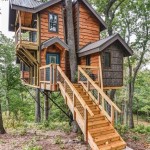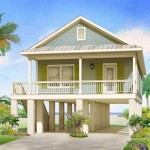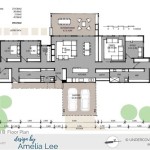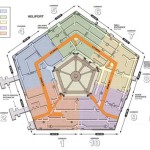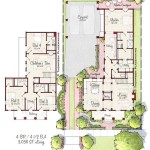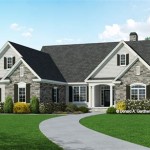Half Cape Floor Plans: A Blend of Charm and Practicality
Half Cape houses, also known as Cape Cods, represent a timeless architectural style originating in New England. Characterized by their symmetrical facades, steep roofs, and often featuring dormers, they offer a classic aesthetic appeal. A key aspect of their design lies in the flexible and adaptable floor plans, especially evident in the half Cape variation.
The distinction between a full and a half Cape lies primarily in the second story. A full Cape typically has a full second story with finished rooms mirroring those below. A half Cape, however, features a second story that is only partially finished, often utilizing the sloping roofline to create cozy, tucked-away spaces. This difference creates a variety of layout possibilities, allowing homeowners to customize the upper level to their specific needs.
One of the most significant advantages of half Cape floor plans is their inherent adaptability. The unfinished second story provides a blank canvas for expansion. Homeowners can initially utilize this space for storage, gradually finishing it into additional bedrooms, bathrooms, or even a home office as their needs and budget allow. This flexibility makes half Capes an attractive option for young families anticipating future growth.
Typical half Cape floor plans on the first level often feature a living room, dining room, kitchen, and potentially a small bedroom or study. The layout often centers around a central chimney, providing a focal point and facilitating efficient heating. The placement of the staircase to the second floor varies, sometimes located centrally and other times tucked against an exterior wall to maximize living space.
The second story of a half Cape presents numerous design possibilities. The sloping rooflines create unique architectural features and cozy nooks. Common uses for this space include bedrooms, playrooms, home gyms, or storage areas. Dormers can be added to increase headroom and natural light, significantly enhancing the usability of these spaces. Careful consideration of window placement maximizes the benefits of natural light and ventilation.
The exterior of half Capes often maintains the traditional symmetrical design. The front door is typically centered, flanked by equally spaced windows. Siding materials vary, commonly using wood shingles, clapboard, or brick. The steep roofline, a defining characteristic of Cape Cod architecture, not only contributes to the aesthetic appeal but also aids in shedding snow and rainwater, a practical consideration in colder climates.
Modern adaptations of half Cape floor plans incorporate open-concept designs, blending the living room, dining room, and kitchen into a single cohesive space. This layout enhances the sense of spaciousness and facilitates interaction among family members. Larger kitchens with islands and ample counter space are frequently incorporated, reflecting contemporary lifestyle preferences.
Consideration of energy efficiency is crucial in modern half Cape designs. Effective insulation, particularly in the attic space, plays a vital role in regulating temperature and reducing energy consumption. High-performance windows and doors further contribute to energy savings. Incorporating sustainable materials and practices during construction aligns with environmentally conscious design principles.
The size and layout of half Cape floor plans can vary significantly. Smaller designs may offer around 1,000 square feet of living space, while larger versions can exceed 2,000 square feet. The number of bedrooms and bathrooms can be adapted to suit individual needs. Careful planning and collaboration with an architect or designer ensure the final floor plan optimizes space utilization and functionality.
Choosing a half Cape floor plan involves careful consideration of lifestyle, budget, and future needs. The flexibility of the design allows for customization and expansion, making it an attractive option for a variety of homeowners. Thorough research and understanding of the various design options ensure a home that reflects individual preferences and provides comfortable living for years to come.
Exploring different half Cape floor plans online and in architectural publications provides valuable insights into the range of possibilities. Consulting with architects and builders experienced in Cape Cod style homes offers expert guidance throughout the design and construction process. Careful consideration of site orientation and local building codes ensures the chosen design harmonizes with the surrounding environment and meets regulatory requirements.
Ultimately, the appeal of half Cape floor plans lies in their ability to blend traditional charm with modern practicality. The adaptability of the design, combined with the classic aesthetic, makes them a timeless choice for homeowners seeking a comfortable and enduring living space.

Cape Early New England Homes

Plan 95015 Cape Cod Style With 3 Bed Bath

Cape Cod House Style A Free Ez Architect Floor Plan For Windows

Plan 81045w Expandable Cape With Two Options Cod House Plans Narrow Lot Layout

Small Mid Century Cape Cod Cottage Nationwide House Plan Service 1950s Houses The Ranch Style Plans Vintage

House Plan 49128 Country Style With 1339 Sq Ft 2 Bed Bath

House Plan 86101 Southern Style With 1738 Sq Ft 3 Bed 2 Bath

Tiny Cape Cod Center Hall Mid Century Cottage Style Nationwide House Plan Service T Plans

House Plan 60911 Craftsman Style With 2052 Sq Ft 3 Bed 2 Bath

House Plan 86345 Southern Style With 1824 Sq Ft 3 Bed 2 Bath


